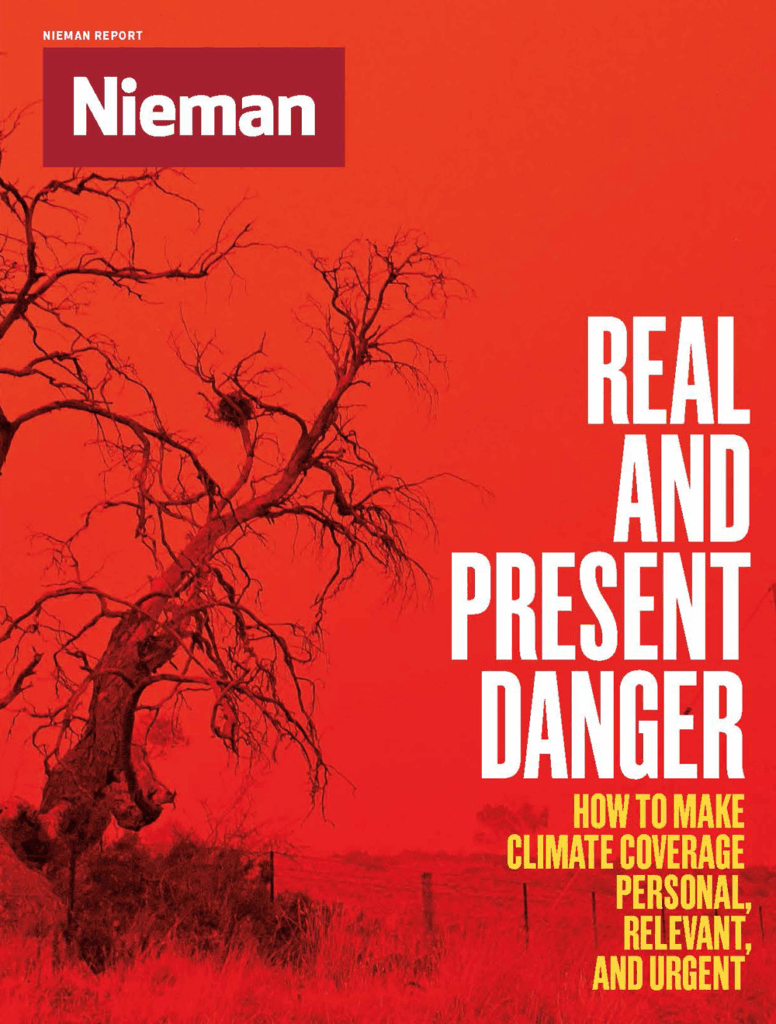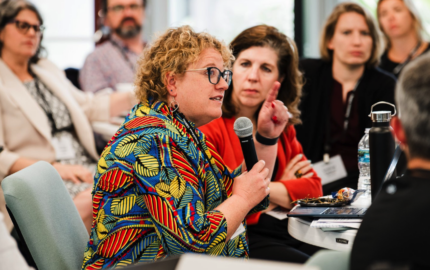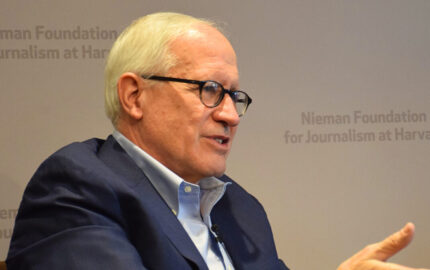That’s something Vega has worked to address throughout her journalism career. She has often focused on race, inequality, criminal justice, and the media. Vega in 2013 was the first — and only — New York Times reporter on the national race and ethnicity beat, a beat she pitched to the paper’s then-executive editor Jill Abramson. Two years later, the position was eliminated, eliciting an uproar from journalists and readers alike. She soon jumped to CNN, where she reported on race and inequality.
At “The Takeaway,” Vega has worked to give the show a unique identity. “About a year or two ago, Christiane Amanpour was quoted as saying she believes in being truthful, not neutral. I immediately was like, ‘I like that. That’s where I want to go with the show,’” said Vega. By providing longer segments, Vega has shifted the show’s focus away from headlines to analysis and context.
Vega is also the author of a forthcoming book about the future of women of color in the U.S. called “Uppity: Women, Race and Class in America,” to be published by Bold Type Books. Vega considers the term “uppity” to be a uniquely American concept — a pejorative term used mostly against people of color, and women in particular —describing people who “step out of place” and assert themselves where some think they don’t belong.
During her visit to Lippmann House, Vega discussed promoting newsroom diversity, the Times’s decision to eliminate the race and ethnicity beat, and more. Edited excerpts:
On covering race
Tanzina Vega: When I started the [national race and ethnicity] beat at The New York Times in 2013, the intent was not to do that as a separate beat forever. In fact, I wanted it to be incorporated into the regular report.
That’s one of the reasons why we chose to make it part of the national desk coverage, so that it would be something I could take anywhere. You could do stories on healthcare, you could do stories on housing, etc.
At the outset, we realized we’re just not covering these demographic shifts in the country the way we should. They’re going to have a really big effect on our country as a whole. Let’s think about a way to do that in a smart, Times-ian way. Then you had the emergence of Black Lives Matter and everything else.
Ultimately, what I wanted to see was more comprehensive coverage at the paper as a whole. But because there was such a lack of coverage about these communities and these intersections, I just said, “We need to start somewhere.“
Fast-forward to the 2016 election and the broader media narratives around race really centered just on communities of color. We don’t talk about race when we talk about white Americans. Identity politics and race are strictly topics that are reserved for black and brown reporters to cover about black and brown communities. I think that’s a mistake. We saw that writ large in the 2016 election. What the president was campaigning on, and a lot of these conversations that were happening around race were really also about what white Americans were feeling. We just had different names for them, like “working‑class Americans.”
We all need to look at race as something that is germane to the founding of this country. That’s where it gets really uncomfortable. Talking about how we got here, and looking at data, looking at numbers.
If you’re uncomfortable with conversations around slavery or around the broader topics of race, then I have much data to show you that prove the point of inequality and disparate impact without having to mention those uncomfortable things. You can approach covering race from a number of different angles, but I don’t think it should be one person, one beat, one topic per se.
The beat was killed with no plans to move forward. Readers were very upset about the fact that at it was killed and that there was no plan to move it forward. Even the public editor, who was Margaret Sullivan at the time, wrote a column about, why do this? Why do this in the midst of Ferguson, in the midst of Eric Garner, and everything else that we're seeing? In the midst of Black Lives Matter, how could you make this decision? The Times no longer has a public editor. Read into that what you will. They created a newsletter about race relations in the United States.
On prioritizing diversity in the newsroom
There are many pitfalls, but one of them is going forward with the approach of “Hi, you’re a woman, you’re an older person, you’re whatever — black, brown. I need to diversify my newsroom. Come on in.“
That’s awkward. We know you need to diversify your newsroom. It’s abundantly clear that almost all newsrooms need diversity. You don’t want to make someone feel like they’re there to just check off a box.
The reason why I say that is because often these diversity initiatives are born out of reaction. They’re not born from the ground up. They’re not born with the mission of the news organization in mind, or at least not front of mind.
I think what that does is it undermines the person who’s coming in. It undermines their contributions, their experience, the reason why they’re there. You’re not going to hire somebody because they’re incapable of the job and they just happened to check a box. Ideally, whatever boxes you want to check, that person also is capable of the work and has demonstrated that capability in the past.
Newsrooms have to get better at who is sitting at the table, particularly for big projects. One of the pitfalls when it comes to hiring somebody just because of who they are is then you don’t give them the institutional support. You’re just “OK, whew, we got a woman. Whew. Move on.“
Then the woman is sitting there, or the person of color is sitting there like, “What now?“ It’s not organic. You need to incorporate that person or those folks into critical projects.
One of the things I always look for is, who’s on your investigative team? Who is at your White House press corps? Who is the person that you’re allowing to go out? At the very top, we want to have prestige jobs that are filled [by diverse leaders] and represent what the country looks like.
On why diversity among the editing staff matters
There is a significant need for [diverse] editors which are, unfortunately, positions that are being devalued more and more. When I say editors, I don’t just mean topline editors but also copy editors, people that look at those words and say, “Which ones are we going to use here? What’s the best descriptor for this? What’s the best verb to use here?”
The editing ranks often tend to reflect the rest of the newsroom. In fact, they’re even less diverse. I don’t just mean in print media. I think in all media, in radio, in television —who your senior editors are, who the bookers are, who the executive producers are —matters. Who are the people who are picking up the phone to find guests and putting together scripts and all of that? There’s a need for more voices in these jobs as a whole, or else what ends up happening [is there’s no one to challenge the mainstream narrative].
On a better alternative to mentorships
You don’t have the capacity to mentor everyone. It’s impossible. You just can’t. You have a job to do. That’s why having more organic relationships and more organic placements at newsrooms where you’re working on teams together requires less of a formal mentorship.
Today, whatever you’re working on, you can take a more junior staffer and have them be part of the conversation. It’s not that you want to say, “OK, here, you’re going to go out and win a Pulitzer tomorrow.” It's that you're sitting in a room where decisions are being made. You’re working alongside veteran journalists who’ve done this for a while. You’re understanding how decisions or editorial choices are made. Why are we using that photo? Why are we choosing to process the data this way? What decisions went into making the headline what it was?
And giving somebody, a contributor, a line in that piece, giving them a little piece of a larger project, ultimately provides experience and access to some of the power players in the room.
It's less awkward than being like, “Hi, I’m going to be your mentor.” I also think there is a tough‑love element that has to be incorporated into it. It’s about learning newsroom standards. That has to be a primary part of the conversation. Then we can talk about all the other stuff — how to pitch a story, career development, and what’s the long‑term trajectory.
On promoting from within and hiring from outside
I loved reporting on business at the Times because it crossed over with politics, it crossed over with policy, it crossed over with everything that was happening on Madison Avenue. It was a wonderful beat.
Young journalists that I know are less excited about covering business. They’re not being recruited to cover that. With beats that are less traditional and also with your more prestige beats, start grooming people to get in those positions.
If you’re hiring, ask for more time, ask for more resumes, ask what the recruiting process has been like. Getting transparency into a recruitment process is fairly hard if you’re not in HR, for example; there are lots of layers to what happens in that process.
I try to do my own guerrilla recruiting, if you will. I’m out there DMing people and reaching out to organizations.
What could be done more effectively? We can use these conventions that happen every year way more effectively than they’re currently being used. All the news outlets go and set up their table at the National Association of Black Journalists, for example. That’s great, but how serious are we about what we bring back from those from those conventions? I don’t know.
It’s one of the more challenging aspects of the job because you do have a need to fill a position and you have to fill it with the right person. Oftentimes, those two things don’t connect, which is why I go back to developing people who are in the company.
I do think there is a disconnect now between a lot of younger workers who are like, “Well, if I don’t get what I want, and in the next year, I’m out. I’m walking.” That’s hard because you want to be able to develop somebody.




